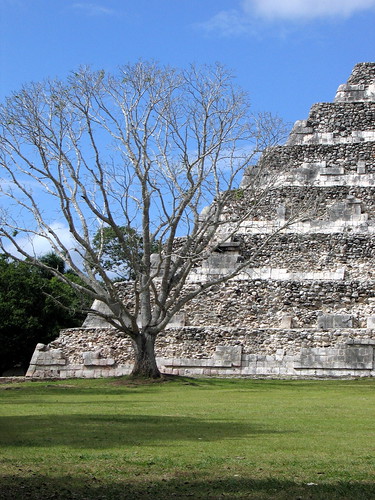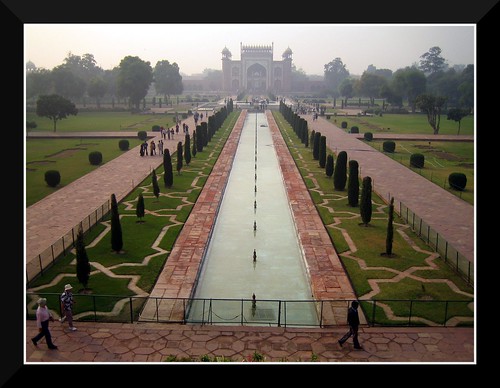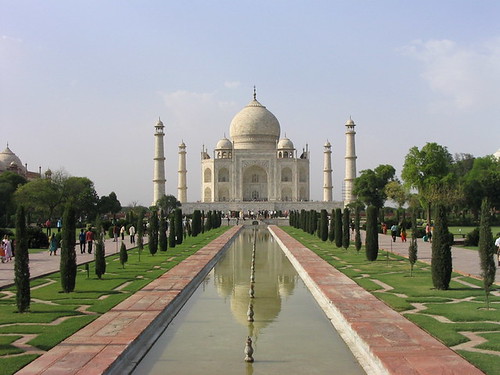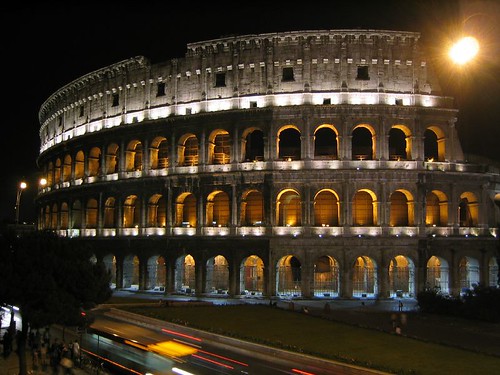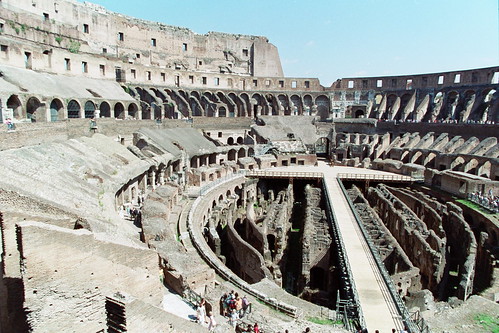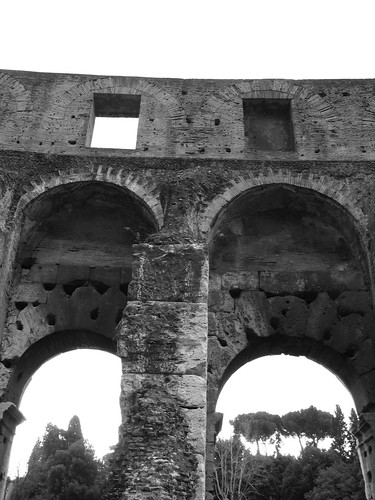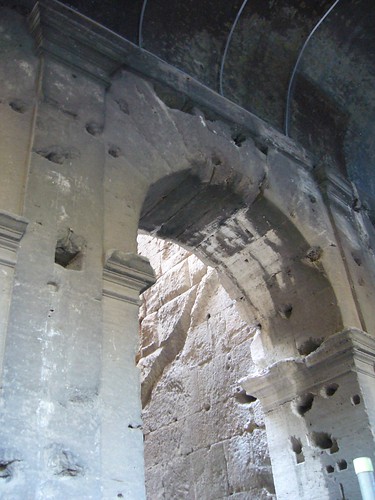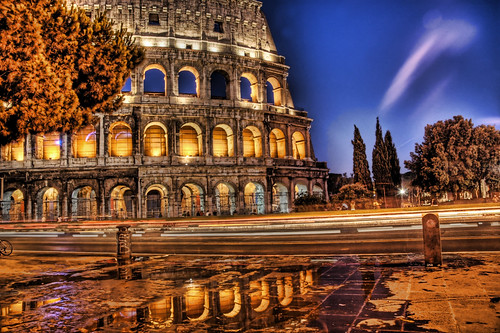Great Pyramid of Giza~One Of The New 7 Wonders Of The World The Great Pyramid of Giza is the oldest and largest of the three pyramids of Giza in the necropolis at the border, was today in Cairo, Egypt and Africa, and is the only remaining member of the Seven Wonders of the World. It is believed to have been built as a tomb for the Fourth Dynasty Egyptian Pharaoh Khufu (hellenized as Χεωψ, Cheops), and constructed over a 20 year period to 2560 BC closure. It is sometimes called Khufu's Pyramid or the Pyramid of Khufu.
The Great Pyramid of Giza is the oldest and largest of the three pyramids of Giza in the necropolis at the border, was today in Cairo, Egypt and Africa, and is the only remaining member of the Seven Wonders of the World. It is believed to have been built as a tomb for the Fourth Dynasty Egyptian Pharaoh Khufu (hellenized as Χεωψ, Cheops), and constructed over a 20 year period to 2560 BC closure. It is sometimes called Khufu's Pyramid or the Pyramid of Khufu.
 The Great Pyramid of Giza is the oldest and largest of the three pyramids of Giza in the necropolis at the border, was today in Cairo, Egypt and Africa, and is the only remaining member of the Seven Wonders of the World. It is believed to have been built as a tomb for the Fourth Dynasty Egyptian Pharaoh Khufu (hellenized as Χεωψ, Cheops), and constructed over a 20 year period to 2560 BC closure. It is sometimes called Khufu's Pyramid or the Pyramid of Khufu.
The Great Pyramid of Giza is the oldest and largest of the three pyramids of Giza in the necropolis at the border, was today in Cairo, Egypt and Africa, and is the only remaining member of the Seven Wonders of the World. It is believed to have been built as a tomb for the Fourth Dynasty Egyptian Pharaoh Khufu (hellenized as Χεωψ, Cheops), and constructed over a 20 year period to 2560 BC closure. It is sometimes called Khufu's Pyramid or the Pyramid of Khufu.Historical context
The Great Pyramid of Giza is the main part of a complex setting of buildings that included two mortuary temples in honor of Khufu (one close to the pyramid and one near the Nile), three smaller pyramids for Khufu's wives, an even smaller "satellite" pyramid, a raised causeway connecting the two temples, and small mastaba tombs surrounding the pyramid for nobles. One of the small pyramids contains the tomb of queen Hetepheres (discovered in 1925), sister and wife of Sneferu and the mother of Khufu. There was a town for the workers of Giza, including a cemetery, bakeries, a beer factory and a copper smelting complex. More buildings and complexes are being discovered by The Giza Mapping Project.
A few hundred metres south-west of the Great Pyramid is a bit smaller pyramid of Khafre, one of Khufu's successor, which is also commonly known as the builder of the Great Sphinx, and a few hundred metres further to the south-west is the Pyramid of Menkaure, Khafre's successor, which is about half as large.
The generally accepted estimated date of completion is c. 2560 BC. Although at this time in opposition to radiocarbon dating evidence, it is loosely supported by a lack of archaeological finds for the existence prior to the fourth dynasty of the civilization population, or with sufficient technical skills in the region.
Khufu's vizier, Hemon, or Hemiunu, is believed by some to be the architect of the Great Pyramid.
Construction theories
Materials and workforce
 Many of the estimates were varied in terms of the workforce needed to build the Great Pyramid. Herodotus, the Greek historian in the 5th Century BC, estimated that the construction of any necessary 100000 workers over 20 years. Recent evidence has been found suggesting that the document was in fact paid, which would require accounting and bureaucratic skills of a high order. Polish architect Wieslaw Kozinski believed that as many as 20 men to carry a 1.5-ton stone block. On the basis of that, he estimated the workforce to 300,000 people on the site, with an additional 60000 off-site. 19th Century Egyptologist William Flinders Petrie suggested that the workforce was largely composed not of slaves, but by the Egyptian rural working population in times when the Nile flooded, and agricultural activity. Egyptologist Miroslav Verner postulated that the work was organized in a hierarchy, consisting of two gangs of 100,000 men, in five zaa or phyle of 20,000 men each, the May were further subdivided according to the abilities of employees. Some research results suggest alternative estimates for the staff accepted size. For example, mathematician Kurt Mendelssohn calculated that the workforce in May were 50,000 men at the most, while Ludwig Borchardt and Louis Croon, the number to 36,000. After Verner, a staff of no more than 30,000 was needed in the construction of the Great Pyramid.
Many of the estimates were varied in terms of the workforce needed to build the Great Pyramid. Herodotus, the Greek historian in the 5th Century BC, estimated that the construction of any necessary 100000 workers over 20 years. Recent evidence has been found suggesting that the document was in fact paid, which would require accounting and bureaucratic skills of a high order. Polish architect Wieslaw Kozinski believed that as many as 20 men to carry a 1.5-ton stone block. On the basis of that, he estimated the workforce to 300,000 people on the site, with an additional 60000 off-site. 19th Century Egyptologist William Flinders Petrie suggested that the workforce was largely composed not of slaves, but by the Egyptian rural working population in times when the Nile flooded, and agricultural activity. Egyptologist Miroslav Verner postulated that the work was organized in a hierarchy, consisting of two gangs of 100,000 men, in five zaa or phyle of 20,000 men each, the May were further subdivided according to the abilities of employees. Some research results suggest alternative estimates for the staff accepted size. For example, mathematician Kurt Mendelssohn calculated that the workforce in May were 50,000 men at the most, while Ludwig Borchardt and Louis Croon, the number to 36,000. After Verner, a staff of no more than 30,000 was needed in the construction of the Great Pyramid.A construction management study (test), the Company Daniel, Mann, Johnson & Mendenhall, in collaboration with Mark Lehner and other Egyptologists, estimates that the total cost of the project required an average workforce of 14567 persons and a maximum of 40,000 employees . Without the use of rollers, wheels, iron tools, or that they suspect the Great Pyramid was from beginning to end in about 10 years. Their critical path analysis study shows, estimates that the number of units under construction was between 2-2.8 million (2.4 million on average), but is aimed at a reduced completed a total of 2 million after deducting the estimated area of the voids the chambers and galleries. Most sources agree on this number of units somewhere over 2.3 million. The Egyptologist 'calculations suggest that workers had sustained a rate of 180 units per hour (3 blocks / minute) with ten hour work day for the implementation of each block. It derives these estimates of construction projects, the non-use of modern machinery. This study is not taken into account, however, especially when compared to modern third-world construction projects, logistics and craftsmanship time inherent construction of a building in almost unprecedented magnitude with such precision, among other things, or the use of up to 60-80 tons of stones as a quarry and transported a distance of about 500 miles.
In contrast, a Great Pyramid feasibility study relating to the quarrying of the stone was performed in 1978 by Technical Director Merle Booker of the Indiana Limestone Institute of America. Consisting of 33 quarries, the Institute is considered by many architects to be one of the world’s leading authorities on limestone. Using modern equipment, the study concludes:
“Utilizing the entire Indiana Limestone industry’s facilities as they now stand [for 33 quarries], and figuring on tripling present average production, it would take approximately 27 years to quarry, fabricate and ship the total requirements.”
Booker points out the time study assumes sufficient quantities of railroad cars would be available without delay or downtime during this 27 year period and does not factor in the increasing costs of completing the work.
The entire Giza Plateau is that they were built during the reign of five Pharaohs in less than a hundred years ago. In the hundred years before Giza, beginning with Djoser, from 2687-2667 BC, three massive pyramids built - Step Pyramid of Saqqara (as one of the first Egyptian pyramid), the Bent Pyramid and the Red Pyramid. Also during this period (2686 to 2498 BC) the Wadi Al-Garawi dam, used an estimated 100000 cubic meters of rock and rubble was built.
The values adopted by Egyptologists, the following result: 2,400,000 stones used ÷ ÷ 20 years 365 days per year ÷ 10 hours of work per day ÷ 60 minutes per hour = 0.55 per minute stones gelegt.The entire Giza Plateau is that they were built during the reign of five Pharaohs in less than a hundred years ago. In the hundred years before Giza, beginning with Djoser, from 2687-2667 BC, three massive pyramids built - Step Pyramid of Saqqara (as one of the first Egyptian pyramid), the Bent Pyramid and the Red Pyramid. Also during this period (2686 to 2498 BC) the Wadi Al-Garawi dam, used an estimated 100000 cubic meters of rock and rubble was built.
The values adopted by Egyptologists, the following result: 2400000 stones used ÷ ÷ 20 years 365 days per year ÷ 10 hours of work per day ÷ 60 minutes per hour = 0.55 per minute stones.
Thus no matter how many workers were used or in what configuration, 1.1 blocks on average would have to be put in place every 2 minutes, ten hours a day, 365 days a year for twenty years to complete the Great Pyramid within this time frame. This equation, however, does not take into account among other things the designing, planning, surveying, and leveling the 13 acre site the Great Pyramid sits on.
As Egyptologist Dr. I.E.S. Edwards, former Keeper of Antiquities in the British Museum, said in his book The Pyramids of Egypt; " Cheops, who may have been a megalomaniac, could never, during a reign of about twenty-three years, have erected a building of the size and durability of the Great Pyramid, if technical advances had not enabled his masons to handle stones of very considerable weight and dimensions".
Layout
 Papyrus documents and existing cubit measuring rods give us the units of measure used to specify the plan of the pyramid and so it is thought that, at construction, the Great Pyramid was 280 Egyptian royal cubits tall (146.6 meters or 480.9 feet), but with erosion and the theft of its topmost stone (the pyramidion) its current height is 138.8 m. Each base side was 440 royal cubits, with each royal cubit measuring 0.524 m (20.6 inches). Thus, the base was originally almost 231 m on a side and covered approximately 53,000 square metres with a slope angle of 51°50'40" (seked = 5½).
Papyrus documents and existing cubit measuring rods give us the units of measure used to specify the plan of the pyramid and so it is thought that, at construction, the Great Pyramid was 280 Egyptian royal cubits tall (146.6 meters or 480.9 feet), but with erosion and the theft of its topmost stone (the pyramidion) its current height is 138.8 m. Each base side was 440 royal cubits, with each royal cubit measuring 0.524 m (20.6 inches). Thus, the base was originally almost 231 m on a side and covered approximately 53,000 square metres with a slope angle of 51°50'40" (seked = 5½).Today each side of the pyramid has an approximate length of about 230.4 meters (755.8 feet). The reduction in size and area of the structure into its current rough-hewn appearance is due to the absence of its original polished casing stones, some of which measured up to two and a half metres thick and weighed more than 15 tonnes.
In the 14th century (1301 AD), a massive earthquake loosened many of the outer casing stones, which were then carted away by Bahri Sultan An-Nasir Nasir-ad-Din al-Hasan in 1356 in order to build mosques and fortresses in nearby Cairo; the stones can still be seen as parts of these structures to this day. Later explorers reported massive piles of rubble at the base of the pyramids left over from the continuing collapse of the casing stones which were subsequently cleared away during continuing excavations of the site. Nevertheless, many of the casing stones around the base of the Great Pyramid can be seen to this day in situ displaying the same workmanship and precision as has been reported for centuries. Regarding this uncanny workmanship, Sir Flinders Petrie remarked; "Merely to place such stones in exact contact would be careful work, but to do so with cement in the joints seems almost impossible: it is to be compared with the finest opticians' work on a scale of acres".
The first precision measurements of the pyramid were done by Sir Flinders Petrie in 1880–82 and published as "The Pyramids and Temples of Gizeh". Almost all reports are based on his measurements. Petrie found the pyramid is oriented 4' west of North and the second pyramid is similarly oriented. Petrie also found a different orientation in the core and in the casing (193 cm ± 25 cm ( – 5 ft 16 in ± 10")). Petrie suggested a redetermination of north was made after the construction of the core, but a mistake was made, and the casing was built with a different orientation. This deviation from the north in the core, corresponding to the position of the stars b-Ursae Minoris and z-Ursae Majoris about 3,000 years ago, takes into account the precession of the axis of the Earth. A study by egyptologist Kate Spence shows how the changes in orientation of 8 pyramids corresponds with changes of position of those stars through time. This would date the start of the construction of the pyramid at 2467 BC.
For four thousand years, it was the tallest building in the world until the unmatched 160-meter high tower of the Cathedral of Lincoln was c. 1300th The accuracy of the pyramid processing is such that the four sides of the base have an average error of only 58 mm in length and 1 minute at an angle from a perfect place. The base is horizontal and flat to within 15 mm. The sides of the square are closely aligned with the four directions compass points within 3 minutes, and archery is not based on magnetic north, north, but true. The design dimensions, the survey by Petrie and all those following this, assumed that Ellen was 280 in the amount of approximately 4x440 Ellen originally, and how these proportions equal to 2 x Pi with an accuracy of better than 0.05%, and that was regarded as the conscious design of proportion by Professor Flinders Petrie, IES Edwards and Verner among many other Egyptologists. Other proportions of the King's Chamber supports this conclusion, and the debate continues as the likely methods of implementation, in the light of information regarding 'seked "slope angle techniques and geometric problems associated with pyramids from the Rhind papyrus.
The pyramid was constructed of cut and dressed blocks of limestone, basalt or granite. The core was made mainly of rough blocks of low quality limestone taken from a quarry at the south of Khufu’s Great Pyramid. These blocks weighed from two to four tonnes on average, with the heaviest used at the base of the pyramid. An estimated 2.4 million blocks were used in the construction. High quality limestone was used for the outer casing, with some of the blocks weighing up to 15 tonnes. This limestone came from Tura, about 14 km away on the other side of the Nile. Granite quarried nearly 800 km away in Aswan with blocks weighing as much as 60-80 tonnes, was used for the King's Chamber and relieving chambers.
The total mass of the pyramid is estimated at 5.9 million tonnes with a volume (including an internal hillock) believed to be 2,600,000 cubic metres. The pyramid is the largest in Egypt and the tallest in the world. It is surpassed only by the Great Pyramid of Cholula in Puebla, Mexico, which, although much lower in height, occupies a greater volume.
At completion, the Great Pyramid was surfaced by white 'casing stones' – slant-faced, but flat-topped, blocks of highly polished white limestone. These caused the monument to shine brightly in the sun, making it visible from a considerable distance. Visibly all that remains is the underlying step-pyramid core structure seen today, but several of the casing stones can still be found around the base. The casing stones of the Great Pyramid and Khafre's Pyramid (constructed directly beside it) were cut to such optical precision as to be off true plane over their entire surface area by only 0.5 mm. They were fitted together so perfectly that the tip of a knife cannot be inserted between the joints even to this day.
The passages inside the pyramid are all extremely straight and precise, such that the longest of them, referred to as the descending passage, which is 107 m long, deviates from being truly straight by less than 6 mm, while one of the shorter passages with a length of just over 15 m deviates from being truly straight by a mere 0.5 mm.
 The Great Pyramid differs in its internal arrangement of the other pyramids in the area. The larger number of chambers and corridors, the high surface of parts of the work, and the accuracy of all construction. The walls throughout the pyramid are completely bare and uninscribed, but there are inscriptions - or to be precise, graffiti - to have believed that the workers over the stones before they were assembled. All five discharge of the chambers are enrolled. The famous inscription is one of the few mentions that the name of Khufu, he says, "17 years of Khufu's reign." Although alternative theorists have suggested otherwise, given their precarious situation, it is hard to believe that it would have after the construction registered, even Graham Hancock accepted after Dr. Hawass led him to the inscription. Another inscription refers to the "Friends of Khufu," and probably was the name of one of the gangs of workers. Although this does not provide undeniable evidence Khufu was the construction of the Great Pyramid or when construction began, but it seems clear he has no doubt at least partly, in some stage of its construction (or higher repairs to an existing building) during his reign.
The Great Pyramid differs in its internal arrangement of the other pyramids in the area. The larger number of chambers and corridors, the high surface of parts of the work, and the accuracy of all construction. The walls throughout the pyramid are completely bare and uninscribed, but there are inscriptions - or to be precise, graffiti - to have believed that the workers over the stones before they were assembled. All five discharge of the chambers are enrolled. The famous inscription is one of the few mentions that the name of Khufu, he says, "17 years of Khufu's reign." Although alternative theorists have suggested otherwise, given their precarious situation, it is hard to believe that it would have after the construction registered, even Graham Hancock accepted after Dr. Hawass led him to the inscription. Another inscription refers to the "Friends of Khufu," and probably was the name of one of the gangs of workers. Although this does not provide undeniable evidence Khufu was the construction of the Great Pyramid or when construction began, but it seems clear he has no doubt at least partly, in some stage of its construction (or higher repairs to an existing building) during his reign.There are three known chambers inside the Great Pyramid. These are arranged centrally, on the vertical axis of the pyramid. The lowest chamber (the "unfinished chamber") is cut into the bedrock upon which the pyramid was built. This chamber is the largest of the three, but totally unfinished, only rough-cut into the rock.
The middle chamber, or Queen's Chamber, is the smallest, measuring approximately 5.74 by 5.23 metres, and 4.57 metres in height. Its eastern wall has a large angular doorway or niche, and two narrow shafts, about 20 cm wide, extending from the chamber towards the outer surface of the pyramid. These shafts were explored using a robot, Upuaut 2, created by the German engineer Rudolf Gantenbrink. Upuaut 2 discovered that these shafts were blocked by limestone "doors" with eroded copper "handles". During Pyramids Live: Secret Chambers Revealed, National Geographic filmed the drilling of a small hole in the southern door only to find another larger door behind it. The northern passage (which was harder to navigate due to twists and turns) was also found to have a door. Egyptologist Mark Lehner believes that the Queen's chamber was intended as a serdab—a structure found in several other Egyptian pyramids—and that the niche would have contained a statue of the interred. The Ancient Egyptians believed that the statue would serve as a "back up" vessel for the Ka of the Pharaoh, should the original mummified body be destroyed. The true purpose of the chamber, however, remains uncertain.
At the end of the lengthy series of entrance ways leading into the pyramid interior is the structure's main chamber, the King's Chamber. This chamber was originally 10 x 20 x 11.2 cubits, or about 5.25 m x 10.5 m x 6 m, comprising a double 10x10 cubit square, and a height equal to half the double square's diagonal. This is consistent with then-available geometric methods for determining the Golden Ratio phi, which can be derived from other dimensions of the pyramid, such that if phi had been the design objective, then pi automatically follows to 'square the circle'. Given that pre-hellenistic Egyptians did not have a similar geometric way to determine pi as accurately, it is unlikely that it was preferred over phi as a design objective, especially as phi has been found in other pre-hellenistic Egyptian monuments. (Alexander Badawi. Ancient Egyptian Architectural Design. Berkeley: 1965)
The other main features of the Great Pyramid consist of the Grand Gallery, the sarcophagus found in the King's Chamber, both ascending and descending passages, and the lowest part of the structure mentioned above, what is dubbed the "unfinished chamber".
The Grand Gallery (49 m x 3 m x 11 m) features an ingenious corbel halloed design and several cut "sockets" spaced at regular intervals along the length of each side of its raised base with a "trench" running along its center length at floor level. What purpose these sockets served is unknown. The Red Pyramid of Dashur also exhibits grand galleries of similar design.
The sarcophagus of the King's chamber was hollowed out of a single piece of Red Aswan granite and has been found to be too large to fit through the passageway leading to the King's chamber. Whether the sarcophagus was ever intended to house a body is unknown, but it is too short to accommodate a medium height individual without the bending of the knees (a technique not practised in Egyptian burial) and no lid was ever found.
 The "unfinished chamber" lies 90 ft below ground level and is rough-hewn, lacking the precision of the other chambers. This chamber is dismissed by Egyptologists as being nothing more than a simple change in plans in that it was intended to be the original burial chamber but later King Khufu changed his mind wanting it to be higher up in the pyramid.
The "unfinished chamber" lies 90 ft below ground level and is rough-hewn, lacking the precision of the other chambers. This chamber is dismissed by Egyptologists as being nothing more than a simple change in plans in that it was intended to be the original burial chamber but later King Khufu changed his mind wanting it to be higher up in the pyramid.Two French amateur Egyptologists, Gilles Dormion and Jean-Yves Verd'hurt, claimed in August 2004 that they had discovered a previously unknown chamber inside the pyramid underneath the Queen's Chamber using ground-penetrating radar and architectural analysis. They believe the chamber to be unviolated and could contain the king's remains. They believe the King's Chamber, the chamber generally assumed to be Khufu's original resting place, was not constructed to be a burial chamber.
The King's Chamber contains two "air shafts" that ascend out of the Pyramid and point directly to the star Thuban, and the star Alnitak, in the Orion constellation. The "Queen's" chamber has two air shafts which align to stars as well. These air shafts were supposedly used for ventilation, but given the fact all four were found to be closed off at both ends and only discovered by accident, this idea was eventually abandoned leaving Egyptologists to now conclude they were instead used for ceremonial purposes allowing the Pharaoh's spirit to rise up and out into the stars. Each of these air shafts are about 13 cm in diameter.
Related video from Metacafe and YouTube :
Egyptian Great Pyramid #1 Of Architectural Wonders
This video was taken on the outside the Great Pyramid Khufu and the inside portion of Khafre. The tunnels to enter the pyramid are only 3 ft high so you have to bend over and travel down then up for 2 mins to end the Queen's Chamber.
Are the pyramids made out of concrete, an artificial re-agglomerated limestone? Joseph Davidovits and the Geopolymer Institute crew shows that only few people is able to rapidly and easily produce several tons of pyramid stone blocks.












